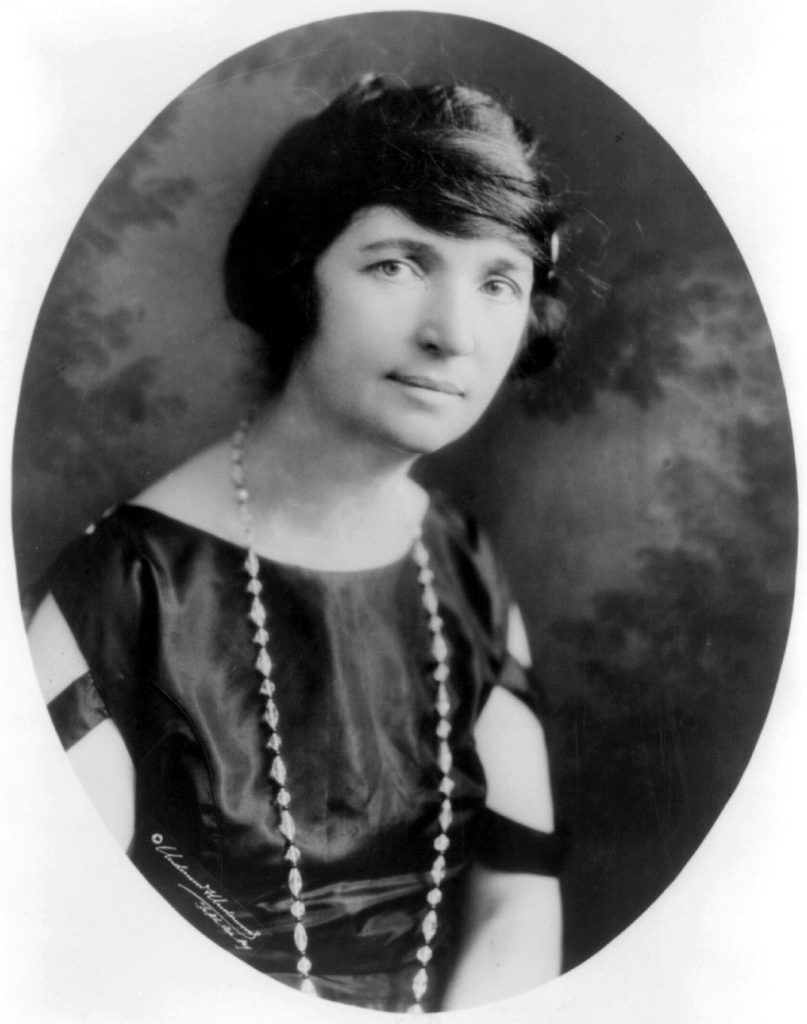Women have proven to be influential when it comes to social reform. During the 1920’s, women began to bob their hair, shorten their skirts, and voice their disdain for various restrictions on women. One of those restrictions involved women’s reproductive health. Margaret Sanger was a pioneer in women’s rights for birth control. Sanger wasn’t afraid to stand up for what she believed in, even if that meant speaking up when the subject was taboo. She was able to help twentieth-century women to gain the right to decide when and if they were to have children. Sanger sought to influence societal norms and cultural beliefs, which have ultimately changed the lives of millions of women to this day.
The 1920s was an eventful decade for women. Not only did women receive the vote, but they also broke longstanding traditions, epitomized by the image of the “flapper.” F. Scott Fitzgerald described the “flappers” of the day as “lovely, expensive, and about nineteen.”1 The flapper attitude was characterized by blunt truth, fast living, and sex. They were seen as reckless and lived in the moment. Most of this, if not all of the behavior was due to World War I. During this time period, men joined the war effort, and women joined the workforce, receiving a paycheck and having disposable wealth, which women used to express their independence. After the war ended, both genders found it difficult to return to society’s previous structure.

“They found themselves expected to settle down into the humdrum routine of American life as if nothing had happened, to accept the moral dicta of elders who seemed to still be living in a Pollyanna land of rosy ideals which the war had killed for them.”2 Before the society’s social structure underwent a transformation, women didn’t necessarily date; they were supposed to wait for a proper suitor to pay them interest, as long as their intentions were good. What once had been “proper” social values were going through changes. One flapper in particular that exemplified these changing values was Margaret Sanger.
On September 14, 1879, Michael Hennessy Higgins and Anne Purcell Higgins gave birth to not only their sixth child (of eleven), but one of the most influential birth-control activists this country has ever known. Aside from the influence growing up with ten siblings, Sanger was also exposed to most of her parents’ Roman Catholic beliefs. After her mother’s death at age fifty, her father relinquished his own Roman Catholic beliefs, and became an atheist. In becoming an atheist, Michael Higgins not only changed his personal views but the views of his children, all the while becoming an activist for women’s suffrage. The views of those who raised her (mainly her father), as well as her personal experiences, helped mold her personal views on sex issues, feminism, and ultimately birth control.3
Shortly after that, during her earlier career, Sanger practiced nursing in the destitute areas of the East Side of New York City. In her nursing career, Sanger was exposed to a high level of poverty that included exposure to poor families, and to women that had frequent childbirths, miscarriages, and abortions. During this time working, she started writing educational columns for women, including “What Every Mother Should Know,” and she helped many women who wished to terminate their pregnancies.4 In her experience with the often hidden aspects of child-bearing, Sanger determined the principal focus of her activism: birth control. Because of the things she witnessed, Sanger decided to take the next step in her activism. In March 1914, Sanger published The Woman Rebel, a newspaper that was devoted to educating and raising the consciousness of working women. “This journal was used to assert that every woman has the right to be an ‘absolute mistress of her own body’ including the right to practice birth control.”5
In April 1914, Sanger was notified by the postal authorities that she had violated obscenity laws due to her newspaper. The following May, she declared to the public that The Woman Rebel was “not going to be suppressed by the post office until it has accomplished the work which it has undertaken.”6 Three months later Sanger was formally indicted for violating the Federal Comstock Law. To avoid the risk of spending twenty years in jail, Sanger got on a train to Canada, acquired a false passport, and sailed to England under the name “Bertha Watson.”7 By 1915, after her actions caught the attention of many, Sanger returned to New York to stand trial. Within a few months, her five year old daughter Peggy died of pneumonia. Due to her loss, many expressions of sympathy poured in, and many friends and supporters sent letters and petitions to President Wilson, affirming their support for Sanger.8 With the newly intensified coverage that The Woman Rebel case and the birth control movement had received, to avoid further publicity, the government decided not to press charges.9

Brownsville, New York | Courtesy of Margaret Sanger Papers Project
With this newfound publicity due to The Woman Rebel scandal, Sanger was able to found the first birth control clinic in the United States, on October 15, 1916 in Brownsville, New York. There were some supporters, but others raised their voices against her. Nine days after the grand opening, there was a police raid, and all of the clinic staff (including Margaret Sanger herself) were arrested and prosecuted. In managing these arrests and prosecutions, New York City’s police department may have done more bad than good. Due to the amount of news coverage the arrests made, there were multiple benefactors willing to bail Sanger out, as well as fund the organization. With the newfound publicity, during the month of February 1917, Sanger was able to publish the first issue of her journal, The Birth Control Review.[10. Caroline Katzive, “Margaret Sanger: Demonstrating Leadership and Legacy Through Her Crusade For Women’s Reproductive Rights,” History Teacher 49, no. 1 (November 2015): 130.] She was its editor until 1929, and used her editorials to promote birth control and negative eugenics. “Eugenists emphasize the mating of healthy couples for the conscious purpose of producing healthy children, the sterilization of the unfit to prevent their populating the world with their kind and they may, perhaps, agree with us that contraception is a necessary measure among the masses of the workers, where wages do not keep pace with the growth of the family and its necessities in the way of food, clothing, housing, medical attention, education and the like.”10
Sanger was known for her controversial views. She once proposed allowing Congress to solve “population problems” by appointing a “Parliament of Population.” “Directors representing the various branches of science [in the Parliament would] … direct and control the population through birth rates and immigration, and direct its distribution over the country according to national needs consistent with taste, fitness and interest of the individuals.”11 One interesting view in particular Sanger had, was the way she differentiated “Eugenists” and “Birth Control Advocates.”
We who advocate Birth Control, on the other hand, lay all our emphasis upon stopping not only the reproduction of the unfit but upon stopping all reproduction when there is not economic means of providing proper care for those who are born in health. The eugenist also believes that a woman should bear as many healthy children as possible as a duty to the state. We hold that the world is already over-populated. Eugenists imply or insist that a woman’s first duty is to the state; we contend that her duty to herself is her duty to the state.12
By this point in time, Sanger had made many of the accomplishments toward reaching her initial goals. On November 10, 1921, Sanger founded the American Birth Control League (ABCL) in New York City. She established ABCL to offer an ambitious program of education, legislative reform, and research. Her goal was to build a truly national organization with representation in every region of the country.13

In 1942, The American Birth Control League became the Planned Parenthood Federation of America.14 Even after the name change, the organization continued to strive. It seems as though Sanger knew just which stepping stones it took to reach her goals all the while never straying away from her views on eliminating the unfit.
Throughout her lifetime, Sanger was able to influence many. Not all of the impact during her time as an advocate for women’s issues was positive, considering her highly controversial views. Compared to the way society was when her activism began in the 1920’s, the country’s relationship with birth control has altered substantially. Sanger’s goal was to build a national organization with representation in every region of the country. Today, “Planned Parenthood is one of the nation’s leading providers of high quality health care…and the nations largest provider of sex education…Planned Parenthood has 56 undefended local affiliates that operate nearly 650 health centers throughout the United States.”15 The views of Margaret Sanger inspired the availability of reproductive health care for women across the nation. Sanger started a process in which her actions ignited a series of changes in societal norms. On September 14, 1879 Michael Hennessy Higgins and Anne Purcell Higgins gave birth to not only a revolutionist, but to the creator of the legacy that continues to be Planned Parenthood.16
- St. James Encyclopedia of Popular Culture, 2000, s.v. “Flappers,” by Jackie Hatton. ↵
- Frederick Allen, Only Yesterday: An Informal History of the Nineteen-Twenties (New York: Harper & Brothers Publishers, 1931), 94-95. ↵
- Salem Press Biographical Encyclopedia, January 2016, s.v. “Margaret Sanger,” by Lesley Croft. ↵
- Salem Press Biographical Encyclopedia, January 2016, s.v. “Margaret Sanger,” by Lesley Croft. ↵
- Caroline Katzive, “Margaret Sanger: Demonstrating Leadership and Legacy Through Her Crusade For Women’s Reproductive Rights,” History Teacher 49, no. 1 (November 2015): 128. ↵
- Margaret Sanger, “The Woman Rebel,” The Ban, (May 1914.): 1 ↵
- Caroline Katzive, “Margaret Sanger: Demonstrating Leadership and Legacy Through Her Crusade For Women’s Reproductive Rights,” History Teacher 49, no. 1 (November 2015): 128-129. ↵
- Caroline Katzive, “Margaret Sanger: Demonstrating Leadership and Legacy Through Her Crusade For Women’s Reproductive Rights,” History Teacher 49, no. 1 (November 2015): 129-130. ↵
- Caroline Katzive, “Margaret Sanger: Demonstrating Leadership and Legacy Through Her Crusade For Women’s Reproductive Rights,” History Teacher 49, no. 1 (November 2015): 129-130. ↵
- Margaret Sanger, “Birth Control and Racial Betterment,” The Birth Control Review (April 1919): 11-12. ↵
- Margaret Sanger, “A Plan for Peace,” The Birth Control Review (April 1, 1932): 107-108. ↵
- Sanger, “Birth Control and Racial Betterment,” The Birth Control Review (April 1919): 11-12. ↵
- Caroline Katzive, “Margaret Sanger: Demonstrating Leadership and Legacy Through Her Crusade For Women’s Reproductive Rights,” History Teacher 49, no. 1 (November 2015): 131. ↵
- Salem Press Biographical Encyclopedia, January 2016, s.v. “Margaret Sanger,” by Lesley Croft. ↵
- Planned Parenthood, “Planned Parenthood at a Glance,” Planned Parenthood, (March 2017): https://www.plannedparenthood.org/about-us/who-we-are/planned-parenthood-at-a-glance/ ↵
- Caroline Katzive, “Margaret Sanger: Demonstrating Leadership and Legacy Through Her Crusade For Women’s Reproductive Rights,” History Teacher 49, no. 1 (November 2015): 132. ↵



46 comments
Jacob Adams
This was a very well written and concise article that explained the life of one of the most influential women of all time. This topic has been very controversial in the last decade and even more so in the past year. However, I wish the article indulged into the controversy of Sanger’s life and accusations against her. She has been labeled many things and it would be helpful to have refute some of those claims against her.
Mckenzie Gritton
Wow what a woman. You really captured her story. She’s really helped to make an impact for women everywhere. It is sad to realize that Planned Parenthood is so controversial today, and that there are still so many people working to regulate women’s bodies. Once again great story, Very well written!
Jacob Galan
I like how this article gives insight to the most controversial organization that we are seeing right now. The article provides what it was like being a woman in the 1920’s and how they were starting to change how they wanted to be treated in society. It is always good whether you are for or against what Sanger was advocating to know the history behind planned parenthood so if you’re trying to establish an argument then reading an article like yours can be helpful in establishing their position.
Eric Yodis
“It seems as though Sanger knew just which stepping stones it took to reach her goals all the while never straying away from her views on eliminating the unfit.” She must have been quite a woman to hold such fascist views so brazenly and openly. Not surprisingly, she demonstrates that it is possible to be both courageous and fascist at the same time… a thoroughly dangerous combination of personality. The other person who was so famously endowed with these characteristics was Adolf Hitler as he espoused similar views of eliminating the unfit. It is shameful she is such a hero today.
Caily Torres
Margaret Sanger helped women gain access to reproductive and sexual healthcare. Sanger advocated and helped women have a say in what they do with their bodies. I cant imagine how brave she had to be to confront an issue like this since it was negatively looked upon in that time period. She was confident in herself and never let anything get in her way. Now planned parenthood is a safe place for women (and men) to gain knowledge on sexual health and get the reproductive healthcare they need. She impacted many lives and it is sad that her hard work is still being shot down now since Planned Parenthood is a very controversial facility.
Yuliana Vasquez
Sagner was able to help thousands of woman when she created her organization and its so amazing how she actully stood up what she believed for even through all the arrest. That was no where near stopping what she wanted to do. She also got lucky that she was able to get fame for believes in birth control, if not she would have gotten her 20 years in prison. I love stories like this one.
Amanda Uribe
Margaret Sanger was such an activist for women’s education. She impacted so many people’s lives. Even today, the topic of planned parenthood is so controversial and I can’t imagine how hard it must have been to be an advocate in the 1920’s. Women had barely had the right to vote when this was happening and I think that she is so inspiring.
Angely Noriega Baron
This is a very informative article on Margaret Sanger. I liked how Sanger wasn’t afraid to stand up for what she believed in and would say what she thought even when the subject was taboo. Most importantly, she was able to help women to gain the right to decide when and if they were to have children. Even though some people found her views controversial, Sanger was correct on stating that women should do what’s best for their own body. Overall, I think it is a good idea to use some form of contraception to those who feel the need to.
Abigale Carney
I think this article did a great job of explaining the importance of Margaret Sanger, and her involvement with Planned Parenthood. I have never truly heard of Planned Parenthood explained in a non-bias manner, so this article was refreshing and gave me a better idea of what I think about it and its influence on society. I think Sanger is a very brave women for branching out with such a controversial topic, especially back then, and she successfully branded Planned Parenthood as a safe place for women in need of help from other women.
Yadira Chavez
This article is really great at telling the story of Margaret Sanger and Planned Parenthood. Even now, over 80 years later, Planned Parenthood is a topic of taboo and it creates a huge conversation with people and politics. There has been a bad picture painted over this organization when in reality it allows women to be kind to themselves, and respect what they want in life. Abortion is only a small part of it. Planned parenthood gives women access that they might otherwise not have, and that is important for their safety. It is inspiring to see what Sanger went through just because she saw a problem and was willing to risk everything to help it.